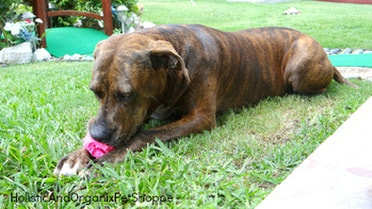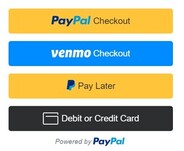
It is normal for dogs to explore the world with their mouths. However, chewing can be directed onto appropriate items so your dog is not destroying items you value. Until he has learned what he can and cannot chew, it is your responsibility to manage the situation as much as possible, so he doesn’t have the opportunity to chew on unacceptable objects.
Taking Control by Managing the Situation
• Take responsibility for your own belongings. If you don’t want it in your dog’s mouth, don’t make it available.
Keep clothing, shoes, books, trash, eyeglasses, cell phones and remote controls out of your dog’s reach.
• Don’t confuse your dog by offering him shoes and socks as toys and then expect him to distinguish between his shoe and yours. Your dog’s toys should be obviously different from household goods.
• Until he learns the house rules, confine him when you are unable to keep an eye on him. Choose a “safe place” that is dog proof with fresh water and “safe” toys.
If your dog is crate trained, you may also crate him for short periods of time.
Taking Control by Managing the Situation
• Take responsibility for your own belongings. If you don’t want it in your dog’s mouth, don’t make it available.
Keep clothing, shoes, books, trash, eyeglasses, cell phones and remote controls out of your dog’s reach.
• Don’t confuse your dog by offering him shoes and socks as toys and then expect him to distinguish between his shoe and yours. Your dog’s toys should be obviously different from household goods.
• Until he learns the house rules, confine him when you are unable to keep an eye on him. Choose a “safe place” that is dog proof with fresh water and “safe” toys.
If your dog is crate trained, you may also crate him for short periods of time.
• Give your dog plenty of people time. Your dog won’t know how to behave if you don’t teach him alternatives to inappropriate behavior and he can’t learn these when in the yard by himself.
• Take your dog to an obedience class to teach him important commands, like “leave it.” Classes may have the added benefit of reducing destructive behavior because they will help your dog burn off some excess energy.
• If, and only if, you actually catch your dog chewing on something he shouldn’t, interrupt the behavior with a loud noise and offer him an acceptable chew toy instead. Praise him lavishly when he takes the toy in his mouth.
• Have realistic expectations. It is virtually inevitable that your dog will, at some point, chew up something you value. This is often part of the transition to a new home.
Chewing is normal teething and investigative puppy behavior; however, dogs will engage in destructive behavior for a variety of reasons. In order to deal with the behavior, you must first determine why your dog is being destructive.
• Take your dog to an obedience class to teach him important commands, like “leave it.” Classes may have the added benefit of reducing destructive behavior because they will help your dog burn off some excess energy.
• If, and only if, you actually catch your dog chewing on something he shouldn’t, interrupt the behavior with a loud noise and offer him an acceptable chew toy instead. Praise him lavishly when he takes the toy in his mouth.
• Have realistic expectations. It is virtually inevitable that your dog will, at some point, chew up something you value. This is often part of the transition to a new home.
Chewing is normal teething and investigative puppy behavior; however, dogs will engage in destructive behavior for a variety of reasons. In order to deal with the behavior, you must first determine why your dog is being destructive.
|
Play, Boredom and/or Social Isolation
Normal play behavior can result in destruction, as it may involve digging, chewing, shredding and/or shaking toy-like objects. Since dogs investigate objects by pawing at them and exploring them with their mouths, they may inadvertently damage items in their environment. Your dog may be chewing for entertainment if: • He’s left alone for long time periods without opportunities for interaction with you or other family members. • His environment is relatively barren, without playmates or toys. • He’s a puppy or adolescent (under 3 years old) and he doesn’t have other outlets for his energy. • He’s a particularly active type of dog (like the herding or sporting breeds) who needs an active lifestyle to be happy. |
Solutions:
• Play with your dog daily in a safe, fenced-in area. If you don’t have a yard, a tennis court can be a good place to play. Fetch is a great game that will use up your dog’s excess energy without wearing you out!
• Go for a walk. Walks should be more than just “bathroom time.” On-leash walks are important opportunities for you and your dog to be together. Don’t forget to allow time for sniffing, exploring, instruction and praise.
• Increase your dog’s opportunities for mental stimulation. Teach your dog a few commands and/or tricks and practice them daily. If you have time, take an obedience class.
• Provide your dog with lots of toys.
• Rotate your dog’s toys to refresh his interest in them. “New” toys are always more interesting than old ones.
• Try different kinds of toys, but when you introduce a new toy, watch your dog to make sure he won’t tear it up and ingest the pieces.
• Consider the various types of toys that can be stuffed with food. Putting tidbits of food inside chew toys focuses your dog’s chewing activities on these toys instead of on unacceptable objects.
• Make your dog’s favorite off-limits chew objects unattractive to him by covering them with heavy plastic, aluminum foil, hot pepper sauce or a commercial “anti-chew” product.
• Consider a good doggie day care program for two or three days a week to work off some of your dog’s excess energy.
• Play with your dog daily in a safe, fenced-in area. If you don’t have a yard, a tennis court can be a good place to play. Fetch is a great game that will use up your dog’s excess energy without wearing you out!
• Go for a walk. Walks should be more than just “bathroom time.” On-leash walks are important opportunities for you and your dog to be together. Don’t forget to allow time for sniffing, exploring, instruction and praise.
• Increase your dog’s opportunities for mental stimulation. Teach your dog a few commands and/or tricks and practice them daily. If you have time, take an obedience class.
• Provide your dog with lots of toys.
• Rotate your dog’s toys to refresh his interest in them. “New” toys are always more interesting than old ones.
• Try different kinds of toys, but when you introduce a new toy, watch your dog to make sure he won’t tear it up and ingest the pieces.
• Consider the various types of toys that can be stuffed with food. Putting tidbits of food inside chew toys focuses your dog’s chewing activities on these toys instead of on unacceptable objects.
• Make your dog’s favorite off-limits chew objects unattractive to him by covering them with heavy plastic, aluminum foil, hot pepper sauce or a commercial “anti-chew” product.
• Consider a good doggie day care program for two or three days a week to work off some of your dog’s excess energy.
Separation Anxiety
Dogs with separation anxiety tend to display behaviors that reflect a strong attachment to their owners. This includes following you from room to room, frantic greetings and reacting anxiously to your preparation to leave the house.
Factors that can precipitate a separation anxiety problem:
• A change in the family’s schedule that results in your dog being left alone more often.
• A move to a new house.
• The death or loss of a family member or another family pet.
• A period at a shelter or boarding kennel.
Dogs with separation anxiety tend to display behaviors that reflect a strong attachment to their owners. This includes following you from room to room, frantic greetings and reacting anxiously to your preparation to leave the house.
Factors that can precipitate a separation anxiety problem:
• A change in the family’s schedule that results in your dog being left alone more often.
• A move to a new house.
• The death or loss of a family member or another family pet.
• A period at a shelter or boarding kennel.
Attention-Seeking Behavior
Without realizing it, we often pay more attention to our dogs when they are misbehaving. Dogs who don’t receive much attention and reinforcement for appropriate behavior may engage in destructive behavior when their owners are present as a way to attract attention – even if the attention is “negative,” such as a verbal scolding. From a dog’s point of view, negative attention is better than no attention at all.
Solutions:
• Make sure your dog gets plenty of positive attention every day – playing, walking, grooming or just petting.
• Ignore (as much as possible) bad behavior and reward only good behavior. Remember to reward your dog with praise and petting when he’s playing quietly with appropriate toys.
• Make his favorite off-limits chew objects unattractive or unavailable to him. Use aversives on objects that cannot be put away.
• Teach your dog a “drop it” command so when he does pick up an off-limits object, you can use your command and praise him for complying. The best way to teach “drop it” is to practice having him exchange a toy in his possession for a tidbit of food.
• Practice “Nothing in Life is Free” with your dog. This gets your dog in the habit of complying with your commands and is a good way to make sure he gets lots of positive attention for doing the right things – so he won’t have to resort to being naughty just to get your attention.
Without realizing it, we often pay more attention to our dogs when they are misbehaving. Dogs who don’t receive much attention and reinforcement for appropriate behavior may engage in destructive behavior when their owners are present as a way to attract attention – even if the attention is “negative,” such as a verbal scolding. From a dog’s point of view, negative attention is better than no attention at all.
Solutions:
• Make sure your dog gets plenty of positive attention every day – playing, walking, grooming or just petting.
• Ignore (as much as possible) bad behavior and reward only good behavior. Remember to reward your dog with praise and petting when he’s playing quietly with appropriate toys.
• Make his favorite off-limits chew objects unattractive or unavailable to him. Use aversives on objects that cannot be put away.
• Teach your dog a “drop it” command so when he does pick up an off-limits object, you can use your command and praise him for complying. The best way to teach “drop it” is to practice having him exchange a toy in his possession for a tidbit of food.
• Practice “Nothing in Life is Free” with your dog. This gets your dog in the habit of complying with your commands and is a good way to make sure he gets lots of positive attention for doing the right things – so he won’t have to resort to being naughty just to get your attention.
Fears and Phobias
Some dogs are afraid of loud noises. Your dog’s destructive behavior may be caused by fear if the destruction occurs when he’s exposed to loud noises, such as thunderstorms, firecrackers or construction sounds, and if the primary damage is to doors, door frames, window coverings, screens or walls.
What Not To Do
Punishment is rarely effective in resolving destructive behavior problems and can even make them worse. Never discipline your dog after-the-fact. If you discover an item your dog has chewed even just a few minutes later, it is too late to administer a correction. Your dog doesn’t understand that, “I chewed those shoes an hour ago and that’s why I’m being scolded now.” People often believe their dog makes this connection because he runs and hides or “looks guilty.” Dogs don’t feel guilt; rather they display submissive postures like cowering, running away or hiding, when they feel threatened by an angry tone of voice, body posture or facial expression. Your dog doesn’t know that he’s done something wrong; he only knows that you’re upset. Punishment after-the-fact will not only fail to eliminate the undesirable behavior, but may also provoke other undesirable behaviors.
Source Unknown
Some dogs are afraid of loud noises. Your dog’s destructive behavior may be caused by fear if the destruction occurs when he’s exposed to loud noises, such as thunderstorms, firecrackers or construction sounds, and if the primary damage is to doors, door frames, window coverings, screens or walls.
What Not To Do
Punishment is rarely effective in resolving destructive behavior problems and can even make them worse. Never discipline your dog after-the-fact. If you discover an item your dog has chewed even just a few minutes later, it is too late to administer a correction. Your dog doesn’t understand that, “I chewed those shoes an hour ago and that’s why I’m being scolded now.” People often believe their dog makes this connection because he runs and hides or “looks guilty.” Dogs don’t feel guilt; rather they display submissive postures like cowering, running away or hiding, when they feel threatened by an angry tone of voice, body posture or facial expression. Your dog doesn’t know that he’s done something wrong; he only knows that you’re upset. Punishment after-the-fact will not only fail to eliminate the undesirable behavior, but may also provoke other undesirable behaviors.
Source Unknown


















